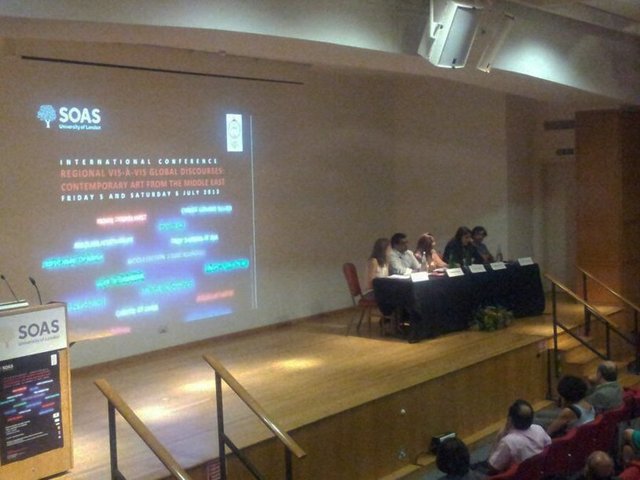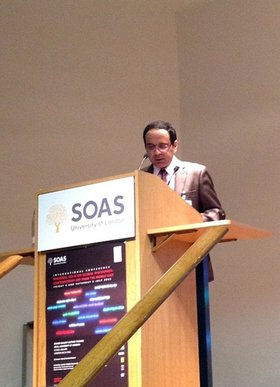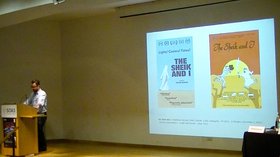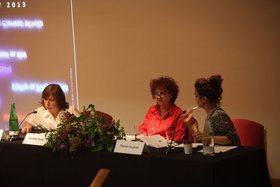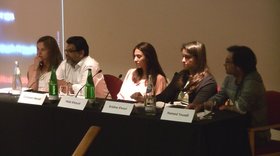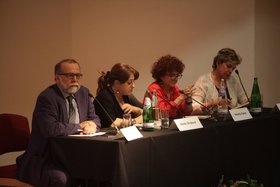News
Critical Anxieties
Regional vis-à-vis Global Discourses: Contemporary Art from the Middle East
The conference, which was also accompanied by a rich screening program curated by Azar Mahmoudian in collaboration with Barbad Golshiri, opened with a welcome by Dr. Hassah Hakimian and an introduction to the conference and its aims by Dr. Keshmirshekan. It continued with keynote speeches by Professors Hamid Dabashi and Irit Rogoff, with Dabashi presenting a speech titled (after the professor's text on Palestinian cinema), 'Trauma, Memory and History'. Dabashi drew on the 'colonial manufactured geographies' of the Middle East, its cultural anxieties and the 'false colonial geographies' that emerged out of the production of nation states within this context. Irit Rogoff expanded this critique in a presentation titled 'Oblique Points of Entry', that explored a certain kind of intertextual trauma that exists in the exhausted geographies of the Middle East as an endless warzone. In this mapping – as binarism gives way to senses of dispersal, fragmentation, regionality and relationality – Rogoff noted that geography is not so much about location as it is about situated knowledge.
This introduction was followed by Dr. Nada Shabout's paper delivered in the first session of the conference chaired by Dabashi and also including speakers Dr. Anthony Downey and Hamid Severi. Titled, 'Mapping Iranian Contemporary Art Publications and Knowledge Production', Shabout pointed towards the marginalisation of modern art production outside of the west through a prevailing perception of modernity as a 'superior western construct'. For Shabout, revisiting such legacies was of great importance in terms of finding a common ground between post-modernity and post-coloniality.
Dr. Anthony Downey's paper 'What Can Art Do? New Pieties and Critical Practices' added a further dimension to Shabout's discussion with the question of what art can, or indeed, is expected to do in relation to critical and curatorial practices. Finding issue with the ethical and political expectations so often placed on art production, Downey asked: 'Should art be expected to be morally and ethically responsible?', 'What forms of collusion are being institutionalized by the ethico-political frames of reference in cultural theory?' and furthermore, 'Where does this will to ethics come from?' Arguing that 'ethics as a discourse has become a dispositif' which has effectively formalized institutional forms of 'righteousness', Downey concluded that ethics has become yet another form of neoliberal-inclined piety. In this rubric, what art can do is to further contest such pieties through practice.
These proposals were echoed in session two of the conference's first day, titled 'Artistic Production from the Middle East and Contemporary Art Discourses'. Part one was comprised of two presentations by Dr. Sonja Metjer-Atassi and Dr. Hamid Keshmirshekan on themes surrounding the documentary turn and the crisis of belonging respectively. Keshmirshekan questioned whether we should be concerned more with 'ethics' than 'ethnics', while making a distinction between information and knowledge production. In turn, Atassi stated how, in documentary and archival practices, collecting functions as a discursive practice. Thinking about counter-narratives and archives, Atassi asserted that engaging in such practices is to further institutional critique while 'questioning the very way we look at events in history'.
In the second part of the session, Dr. Dina Ramadan's paper 'And Again to Authenticity…' then noted how artists in times of revolution are often given a role that is dated and 'doesn't tie up'. Ramadan touched on how, in the Middle East and beyond, we are now witnessing 'a different kind of revolution' that is 'decentralised, undefined' - with no leaders or clear roles. Dr. Abbas Daneshvari spoke next, using the politics of art practice in contemporary Iran as a way in which to explore the deconstructionist ideas around the liberation of signs. The intention of Daneshvari's presentation reflected a general feeling that today, even the language used to discuss art and cultural theory with regards to the Middle East is highly problematic. Professor Dabashi confirmed this during his closing remarks on the conference's second day, as he questioned the language (or more specifically, the 'imperial language') with which such ideas are being discussed.
Day two's first session was titled 'Exposing Contemporary Art in the Middle East', and started with the part one, which discussed problems arising from the cultural exchanges taking place within the context of global and regional contemporary art as evaluated by Jessica Morgan (The Daskalopolous Curator at Tate and member of the Tate's Middle East and North African Acquisitions Committee). This was followed by two presentations in part two, with the first delivered by Assistant Keeper in the Department of the Middle East at the British Museum Dr. Venetia Porter. Porter discussed the histories of the present and the changing worlds of Middle Eastern artists. Next was a study into disaggregating the 'Critical' in post-war contemporary Lebanese art by Dr. Hanan Toukan.
This perspective was then extended into the second session of the day, themed around the public sphere, museum infrastructure and domestic support. In this, Sarah Rogers explored the notion of the 'Global Work of Art' using Beirut as a case study, citing such artists and works as Walid Sadek's Al Banna beach installation in 1993. This was followed by a study into the gallery as historical form by Sarah Neel-Smith, whose paper 'From Galeri to Gallery: Transitioning from Public Forums to Commercial Spaces' traced a historical lineage in the gallery scene of Turkey, via the records of Galeri Maya in Istanbul (1950-54) and Helikon in Ankara (1953-56), against the backdrop of Turkey's transition from a single- to a multi-party system.
The second part of the final day's second session began with papers presented by Hela Darabi and Kirstine Khouri, with Darabi charting the history of the Tehran Museum of Contemporary Art and its various developmental phases and Khouri presenting the history of Kuwait's Sultan Gallery. Khouri then joined a final panel discussion, moderated by Laura Carderera of Delfina Foundation and including panelists Shaheen Merali, Hela Khayat, and Hamed Yousefi. In this, Merali asked: 'What has become of collecting and archiving in this quagmire of information currently at our disposal in the twenty-first century?' In the discussion that followed, it was noted that perhaps more proximity to artists was required when talking about artistic practices pertaining to the region, rather than to heavy academia. This was arguably a critique of the conference itself; the absence of artists was notable for some.
During closing remarks, Professor Dabashi offered his final conclusions on the two-day conference, which tended towards an understanding of the particularities that exist in discussing artistic practices in the Middle East. Dabashi talked about the anxiety of origin or the crisis of identity that so often prevails in art produced in the Middle East, thinking about what Rogoff termed as exhausted geographies. Referring to this, Dabashi noted how such geographies determine, define, frame and confront issues facing a changing world, though it is not totally unprecedented to reconceptualise the geographies on which we produce knowledge today.
In the end, it was this proposal of re-conceptualisation that concluded the discussions that took place over this intensive two-day conference. It is an invitation to engage with a process that is ongoing, changeable and unstable, and which requires the formulation of new approaches, definitions, categories and concepts.
Conference participants: Dr. Hassan Hakimian (Director of London Middle East Institute), Dr. Hamid Keshmirshekan (Conference Convener), Professor Hamid Dabashi (Columbia University), Professor Irit Rogoff (Goldsmiths, University of London), Dr Anthony Downey (Sotheby’s Institute of Art), Dr Nada Shabout (University of North Texas), Hamid Severi (freelance art historian, curator), Dr. Sonja Mejcher-Atassi (American University of Beirut), Dr. Venetia Porter (British Museum), Dr. Dina A. Ramadan (Bard College), Professor Abbas Daneshvari (California State University), Professor Anna Contadini (SOAS, University of London), Jessica Morgan (Tate Modern), Dr. Fereshteh Daftari (freelance curator and scholar), Dr. Dina Matar (SOAS, University of London) Dr. Hanan Toukan (The Forum for Transregional Studies, Berlin), Dr. Sarah A. Rogers (freelance author, academic), Sarah-Neel Smith (University of California, Los Angeles), Helia Darabi (Art University, Tehran), Kristine Khouri (researcher, writer and photographer), Laura Carderera (Delfina Foundation), Shaheen Merali (independent curator), Hala Khayat (Specialist of Modern and Contemporary Arab, Iranian and Turkish Art, Christie’s), Hamed Yousefi (freelance art critic, documentary film-maker)
Organiser: London Middle East Institute
Sponsors: The Barakat Trust, Goethe Institute, Iran Heritage Foundation, Caspian Arts Foundation, Ibraaz, and Shubbak Festival
